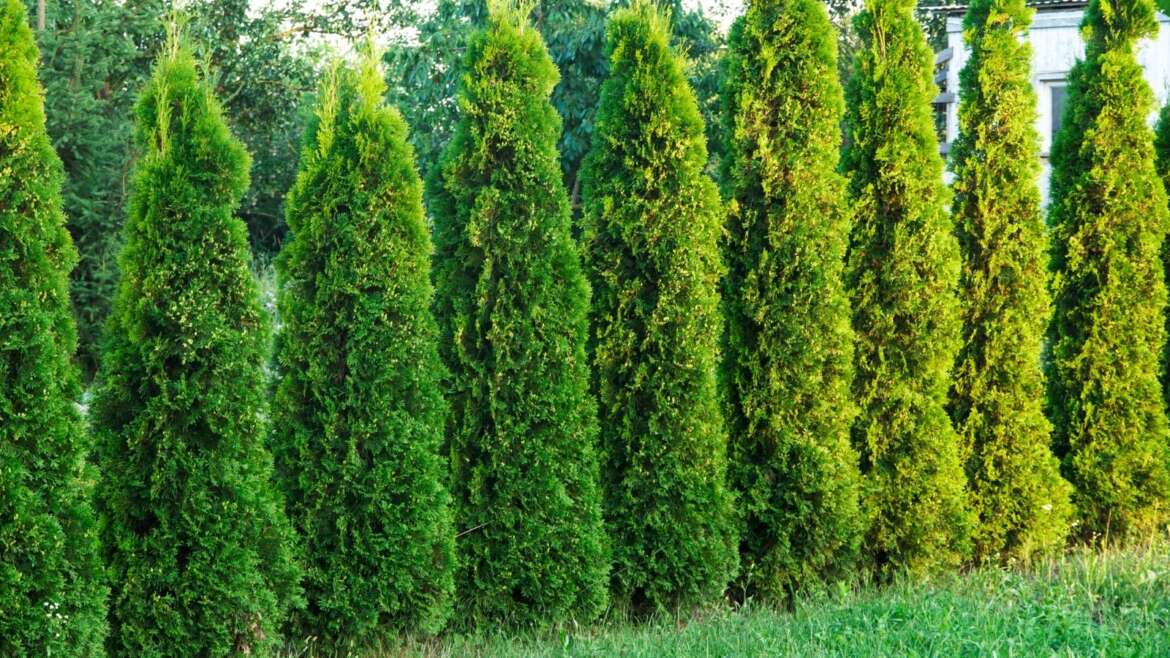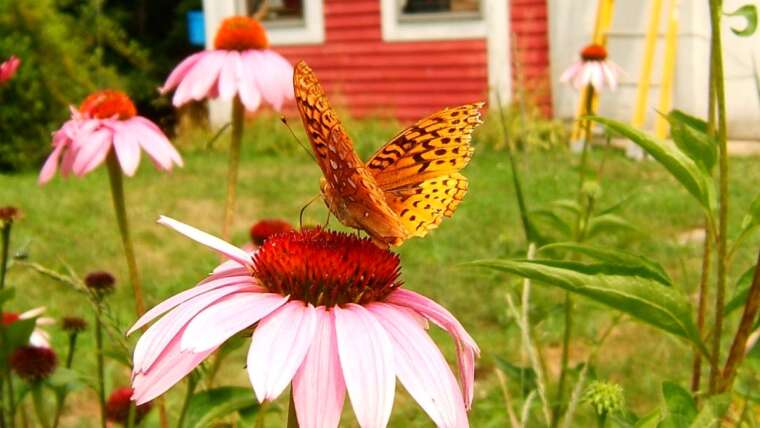Walking by a wall of vibrant green arborvitae makes it easy to fall in love with the plants’ scale-like leaves and woodsy scent. When you consider that they grow about a foot per year, you can see why gardeners and landscapers use them to add both privacy and beauty. But how do these trees stay so green?
Planting them in the proper environment is one part of maintaining vibrant leaves, but ensuring the plants can access the proper type and amount of nutrients is also vital. That’s where fertilization comes into play. Stick with me to learn everything you need to know about fertilizing arborvitae.
Arborvitae Basics
Northern white cedar is popular for privacy and aesthetics.
Arborvitae (Thuja occidentalis) is an evergreen tree native to eastern Canada and parts of the northeast United States. People also refer to these plants as northern white cedar and eastern white cedar.
Since this tree has dense evergreen foliage, it’s a popular option for privacy hedges and windbreaks. That’s why you often see rows of arborvitaes separating yards and lining property boundaries. However, the lacy foliage looks just as beautiful in stand-alone plantings.
Do Arborvitae Need Fertilizer?
 Fertilize arborvitae annually for long-term health.
Fertilize arborvitae annually for long-term health.
The short answer is yes. If you hope to keep your arborvitae healthy for more than a few years, fertilizer is key. However, the long answer is more complex.
While all plants need various nutrients to thrive, you don’t always have to add fertilizers to supply them. Most soil contains a base level of elements due to naturally occurring minerals, decayed organic matter, and other substances. This base level of nutrients is often enough to supply plants with some nutrients, which is one reason why fertilizers don’t always contain micronutrients like boron and copper.
However, in most situations, arborvitae will benefit from regular doses of fertilizer because the native soil doesn’t always have everything it needs. Adding fertilizer once a year will replenish the nutrients the plants used up in the previous year, allowing them to grow well and remain healthy.
The Best Types of Fertilizers for Arborvitae
 Choose a complete fertilizer with higher nitrogen.
Choose a complete fertilizer with higher nitrogen.
If you walk down the nutrient aisle of a gardening store or browse products online, you’ll quickly learn you have a lot of options to choose from. Different products contain various quantities of nutrients, so you can’t just swap out one option for another.
When it comes to arborvitae, look for a “complete” fertilizer that contains the three plant macronutrients: nitrogen (N), phosphorus (P), and potassium (K). Each of these nutrients plays a major role in plant health, so plants require large amounts to stay healthy. Nitrogen is a key component of chlorophyll and proteins, phosphorus helps with plant growth and the transfer of genetic material, and potassium moves water and nutrients through the plant.
Arborvitae prefers higher amounts of nitrogen and lower amounts of phosphorus and potassium. Look for a product with an NPK ratio like 10-4-4 or 11-5-5.
Along with considering the NPK ratio, pay attention to the type of fertilizer. Since arborvitae plants require a steady supply of nutrients throughout the growing season, slow-release fertilizers are a great option. These products gradually release their nutrients over multiple months, so you can apply once a year to meet the plant’s year-round nutrient needs.
Another thing to consider is whether you prefer organic or synthetic fertilizers. Both of these options supply the same types of nutrients, but they’re made from different materials and become available to plants at different times. Organic fertilizers consist of naturally occurring materials like rock dust and chicken feathers, while synthetic ones come from a lab.
Synthetic fertilizers tend to be quick-release but dissipate quickly in the soil, sometimes leaching into waterways. Organic fertilizers usually release nutrients slowly and are less prone to leaching.
Finally, think about what form you prefer. Granular fertilizers come in a solid form that you can easily sprinkle on the ground. Another suitable option is fertilizer spikes that you insert into the ground. Some people think fertilizer spikes are easier to apply, but they’re also more expensive than granular products.
When to Fertilize Arborvitae
 Fertilize in spring before new growth.
Fertilize in spring before new growth.
The spring is the best time to fertilize arborvitae. Aim to feed your plants before new growth or at the time plants are producing new green stems. Fertilizing just once in the spring will supply your plants with enough nutrients for the entire growing season.
Avoid applying after the first day of summer since this can cause the plants to develop new growth late in the season. This late emergent growth is more likely to become damaged by cold temperatures.
There’s no need to add nutrients when planting new arborvitae trees. Adding fertilizer during this time can actually harm these new plants. If you notice your newly planted arborvitae are stunted or discolored, don’t worry. New plants can take a few months to adjust to their new environment.
How to Fertilize Arborvitae
When it’s time to fertilize, follow these steps.
Conduct a Soil Test
 Test the soil for nutrients and pH.
Test the soil for nutrients and pH.
Taking soil samples and submitting them to a lab lets you know exactly what nutrients your soil contains. Plus, it informs you of the soil pH, which greatly influences nutrient availability.
Since trees like arborvitaes have deep root systems, your soil samples should contain the top 12 inches of soil. While a specialized soil probe is the easiest way to obtain a soil sample, you can also use a shovel to collect the top foot of soil.
Most soil labs will allow you to submit a sample and request fertilizer recommendations for specific types of plants. While you may not be able to request recommendations for arborvitae, you will likely be able to request suggestions for general conifer trees.
Choose the Proper Type of Fertilizer
 Pick amendments based on a soil test or opt for slow-release.
Pick amendments based on a soil test or opt for slow-release.
If you’ve taken a soil sample, use it to select a fertilizer that meets your plant’s nutrient needs. But if you’ve opted to forgo soil sampling, choose a complete fertilizer with higher amounts of nitrogen than phosphorus and potassium.
I recommend a slow-release granular fertilizer, as it’s easy to apply and provides your plants with a continuous supply of nutrients.
Water If Necessary
 Moisten soil before application.
Moisten soil before application.
Adding fertilizer to drought-stressed trees carries an increased risk of fertilizer burn. If the soil is dry when you plan to feed the plant, water until it’s damp.
Apply Around the Base of the Trees
 Add the right fertilizer dose based on the canopy area.
Add the right fertilizer dose based on the canopy area.
Selecting the right type of fertilizer is just one aspect of supplying arborvitae with the appropriate amount of nutrients. You also need to ensure you apply the proper dose! Applying too much fertilizer can lead to just as many problems as adding too little, so don’t assume more fertilizer is better.
Most fertilizer labels will supply application instructions in the form of pounds per square foot. When dealing with trees like arborvitaes, consider the area of the plant’s total canopy rather than the area of the trunk.
Measure out the appropriate amount of granular fertilizer and sprinkle it around the tree’s perimeter. If you’re using fertilizer spikes, look at the product directions and apply the appropriate amount around the tree’s base. While you can water in the fertilizer after you apply it, this isn’t necessary.
Final Thoughts
Applying annual doses of an appropriate fertilizer can help keep your arborvitae plants healthy. Remember to choose a balanced fertilizer and apply it during the spring.




